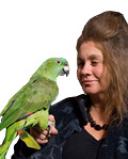SSRIs
The Anatomy of Animal Madness
Is it method or madness that drives animals crazy?
Posted July 17, 2011
Pepper. 'But I don't want to go among mad people,' Alice remarked.
'Oh, you can't help that,' said the Cat: 'we're all mad here. I'm mad. You're mad.'
'How do you know I'm mad?' said Alice.
'You must be,' said the Cat, 'or you wouldn't have come here.

Pepper.
'But I don't want to go among mad people,' Alice remarked.
'Oh, you can't help that,' said the Cat: 'we're all mad here. I'm mad. You're mad.'
'How do you know I'm mad?' said Alice.
'You must be,' said the Cat, 'or you wouldn't have come here.
There's is a lot of talk about crazy animals these days: hair-plucking apes, suicidal dolphins, chimpanzees with psychiatric disorders, homicidal orcas, serial killer elephants—a veritable Everest of documentation describing how animals go mad as readily as humans under the right circumstances. [2,3,4,5] Despair and depression possess every species when their societies implode with the ravages of genocide, and few are spared when subjected to torture and imprisonment, whether in zoos or prisons.
None of this is new. The pernicious effects of animal confinement have been recognized for centuries. Dating back to the early 1900's and before to Darwin, zookeepers and natural historians chronicled feather picking parrots, depressed snakes, infanticidal tigers, and others exhibiting diverse mental disorders [6,7]. What is new is that animals are finally being recognized as someone other than a bundle of behaviors, and that they have minds like us. Today, talk about animal feelings is as popular as their madness. Traditionally, animal distress was called "abnormal" or "aberrant" behavior without any acknowledgement of psyche. Animals behaved, but only humans thought and felt.
However, the human-animal barrier remains jealously guarded. Even those assiduously researching the animal mind, seem bound and determined to keep their subjects at arm's length. Similar to Sisyphus, whenever science showing human-animal comparability achieves the summit leading to legal equivalence, it gets pushed back down, condemned to an endless cycle of proof and dismissal. The incessant rocking and screaming of chimpanzees in bloodless confines of a laboratory cage are insisted to be "signs", only tentatively "similar" to la condition humaine, PTSD [8,9] This despite the growing literature characterizing our closest genetic relative rightly as an agentic, feeling being so epigenetically sensitive as to render their symptoms and subjective experience identical to our own. [3, 4, 10, 11]
Sadly, animal madness, like animals themselves, remains captive to science and scientists. Billions of animals continue to be subjected to excesses of the human mind under the guise of "research," "progress," and the "greater good." The real significance of animal breakdown is shunned. Now, in a twist of irony, it appears that humans are also victims of scientists and the medical profession. Beyond neurobiologies, humans and animals share betrayal by what Vine Deloria, Jr. calls the "exercise of naked power by those in a position to define policies." [12]

Billy.
A recent two-part article in New York Review of Books, authored by the former editor of The New England Journal of Medicine, spins a devastating tale of deceit and conspiracy surrounding the relationship between epidemic mental illness and the research and psychopharmaceutical industries [13]. It turns out that science has been appropriated by a select few, a cabal of psychiatrists, industrialists, and government institutions, to dictate the parameters of mental health:
[A] powerful quartet of voices came together during the 1980's eager to inform the public that mental disorders were brain diseases. Pharmaceutical companies provided the financial muscle. The APA and psychiatrists at top medical schools conferred intellectual legitimacy upon the enterprise. The NIMH [National Institute of Mental Health] put the government's stamp of approval on the story. NAMI [National Alliance on Mental Illness] provided a moral authority." [14,15].
Psychiatric diagnoses are created and handed down from the mount based on the DSM, the mental health profession "Bible" that nonetheless contains "no citations of scientific studies to support its decisions" [15]. Psychoactive drug companies, not science, "determine what constitutes a mental illness and how the disorders should be diagnosed and treated" [13]. Science does not support the assertion that Prozac, Paxil, Zoloft, and Effexor correct brain chemical imbalances presumed to cause depression. The rationale justifying the burgeoning prescription of psychoactive drugs, namely "that mental illness is caused by a chemical imbalance in the brain," holds no water [13].
An exhaustive study [16] found that
drug companies make very sure that their positive studies are published in medical journals and doctors know about them, while the negative ones often languish unseen within the FDA, which regards them as proprietary and therefore confidential. This practice greatly biases the medical literature, medical education, and treatment decisions" [13].
In sum, science and industry have developed "a drug to treat an abnormality, an abnormality [that] was postulated to fit a drug" [13]. After decades and billions of dollars spent on research and testing, it turns out "there is no real antidepressant drug effect at all" [13].
Not only has the public been duped, human lives compromised, and billions of dollars made, but trillions of animals are used, abused, and discarded, their minds and bodies ravaged [17, 18, 19] The use of animals for antidepressant clinical trials illustrates a microcosm of the Dante's Hell to which animals are condemned to fuel the economic engines of research and pharmaceutical empires.
According to a 2004 New York Times article, once first-generation antidepressants, SSRI (Selective serotonin reuptake inhibitors) and TCAs (tricyclics), were discovered, animals were eagerly enlisted "to speed the discovery of other drugs. The idea was for pharmaceutical companies to use animal testing to screen thousands of potential new compounds to pick out those most likely to work in clinical tests on depressed patients" [20]. This approach is considered a "reasonable course of action," because "you can do experiments with animals-examining their brains, giving them high doses of drugs-that you could never do with people" [20]. Animals are used in lieu of humans not only because they are like us, but we can get away with doing things to them that we cannot with other humans.

Jeannie.
At one point, certain antidepressants became associated with suicidality. Since human experimentation with possible fatal consequences was deemed ethically dubious, researchers chose an alternative: mice and rats. However, according to the chairman of the department of psychiatry and behavioral science at Stanford University's School of Medicine, this approach was not viable: "[A]nimal tests work fine for identifying promising new [antidepressant] drugs, [but] they do not mimic anything like human depression"....''we don't have an animal model of depression" [20]. This assertion conflicts with the extensive literature from neurosciences and psychology. [21, 22, 23, 24, 27]
Jeannie.

Jeannie.
Researchers "found by trial and error that the same drugs that make a mouse swim longer are the ones that alleviate depression in humans." [20] Further, explained the president of research and development at Wyeth, (now part of Pfizer Inc., the "world's largest research-based pharmaceutical company" [26]), ''it almost didn't matter what the behavior was...we don't try to relate the behavior in an animal to a human behavior. Animals like mice don't feel happy or sad.'' [20]. Neuroscientists would beg to differ. [27]

Billy.
Despite the haphazard, unethical nature of such research, despite the fact that researchers maintain: "existing animal models of neuropsychiatric disorders...have failed, over several decades, to predict treatment efficacy in humans" [28], the practice continues. Mice continue to swim hopelessly and helplessly and hang in confused desperation suspended by glove garbed hands. At the same time, researchers insist that animals suffering are merely "signs" of "abnormal behavior" [8, 9] and that nonhuman species fail to provide an adequate model for depression [28] antidepressants are administered to domesticated and incarcerated wildlife. [7, 29]
In the midst of this maelstrom of madness, we are assured that there is "a certain rationale at work" [20]. Given the trillion-dollar industry that serves psychiatry, scientists, pharmaceutical companies and their shareholders, it is clear that there is a rationale. There is indeed method to the madness. The antidepressant researchers cry, ''We need new theories.'' [20] It seems, however, that what researchers need are new souls.
Literature Cited
[1] Carroll. L. Alice in Wonderland.
[2] Daily Mail. 2008.Dolphins found dead off Cornish coast 'committed suicide', wildlife expert claims. http://www.dailymail.co.uk/news/article-1025219/Dolphins-dead-Cornish-c… (Accessed June 24, 2011)
[3] Brüne, M., Brüne-Cohrs, & McGrew, W.C. (2004). Psychiatric treatment for great apes? Science, 306, 2039.
[4] Brüne, M., Brüne-Cohrs, U., McGrew, W.C., & Preuschoft, S. (2006). Psychopathology in great apes: concepts, treatment options and possible homologies to human psychiatric disorders. Neurosci. Biobehav., Rev. 30, 1246-1259.
[5] Bradshaw, G.A (2009). Elephant on the edge: What animals teach us about humanity. Yale University Press.
[6] Croke, C. V. 2004. How zoos are driving animals crazy. Boston Globe.http://www.boston.com/news/globe/magazine/articles/2004/09/26/how_zoos_…
[7] Engber, D. 2006. Tears of a panda. Slate. http://www.slate.com/id/2149682/ (Accessed June 25, 2011
[8] Ferdowsian HR, Durham DL, Kimwele C, Kranendonk G, Otali E, et al. (2011) Signs of Mood and Anxiety Disorders in Chimpanzees. PLoS ONE 6(6): e19855. doi:10.1371/journal.pone.0019855
[9] Birkett LP, Newton-Fisher NE (2011) How Abnormal Is the Behaviour of Captive, Zoo-Living Chimpanzees? PLoS ONE 6(6): e20101. doi:10.1371/journal.pone.0020101 (Accessed July 13, 2011)
[10] Bradshaw, G.A. et al. 2008. Building an inner sanctuary: trauma-induced symptoms in non-human great apes. Journal of Trauma and Dissociation. 9(1); 9-34.
[11]Bradshaw, G.A. T. Capaldo, G. Grow, & L. Lindner. 2009. Developmental context effects on bicultural Post-Trauma self repair in Chimpanzees. Developmental Psychology, 45, 1376-1388.
[12] Deloria,Jr. V. 1970. We Talk, You Listen. Macmillan. p. 20.
[13] Angell, M. 2011. The epidemic of mental illness. New York Review of Books. June 23, 2011. http://www.nybooks.com/articles/archives/2011/jun/23/epidemic-mental-il…. Accessed June 24, 20-11.
[14] Angell, M 2011. The Illusions of Psychiatry. New York Review of Books. July 14,
2011.http://www.nybooks.com/articles/archives/2011/jul/14/illusions-of-psych…( Accessed July 9 2011).
[15] Whitaker, R, 2011. Anatomy of an Epidemic: Magic Bullets, Psychiatric Drugs, and the Astonishing Rise of Mental Illness in America. Crown.
[16] Kirsch, I. 2011.The Emperor's New Drugs: Exploding the Antidepressant Myth. Basic Books.
[17] Shapiro, K.J. 1998. Animal Models of Human Psychology: Critique of Science, Ethics and Policy. Hogrefe & Huber.
[18] New England Anti-Vivisection Society (NEAVS). 2011. www.neavs.org
[19] American Anti-Vivisection Society (AAVS). 2011. www.aavs.org
[20] Kolata, G. 2004. Ideas & Trends: Of Mice and Men; Why Test Animals to Cure Human Depression? New York Times./http://www.nytimes.com/2004/03/28/weekinreview/ideas-trends-of-mice-and…, March 28, 2004.
[21] Panksepp J.1998. Affective neuroscience. The foundations of human and animal emotion. Oxford.
[22] Schore, A. N. (2005). Attachment, affect regulation, and the developing right brain: Linking developmental neuroscience to pediatrics. Pediatrics in Review, 26, 204-217.
[23] Bradshaw, G.A., and R. M. Sapolsky. 2006. Mirror, mirror. American Scientist, 94(6), 487-489.
[24] Narvaez, D. & T. Gleason. (in press). Developmental optimization. In D. Narvaez, J. Panksepp, A. Schore, and T. Gleason (Eds.), Human Nature, Early Experience and the Environment of Evolutionary Adaptedness. New York: Oxford University Press.
[25] Hunsberger, J. & C. Duman. 2007. Animal Models for Depression-like and Anxiety-like Behavior. Protocol Exchange, doi:10.1038/nprot.2007.542, 13 December 2007,http://www.nature.com/protocolexchange/protocols/344#/references (Accessed June 24, 201).
[26] Pfitzer Inc. 2011. Pfizer Inc. Welcome. http://www.pfizer.com/welcome/ (Assessed June 24, 2011).
[27] Panksepp, J. (2007) Neuroevolutionary sources of laughter and social joy: Modeling primal human laughter in laboratory rats. Behavioural Brain Research 182 , 231-244
[28] Nestler, E.J. & Hyman,S.E. (2010). Animal models of neuropsychiatric disorders, Nature Neuroscience 13(10),1161-1169.
[29] Mott, M. 2005. "Puppy Prozac:" Can Animals Benefit From Behavioral Meds? National Geographic News. http://news.nationalgeographic.com/news/2005/09/0929_050929_pet_prozac… (Accessed June 24, 2011).
Photo credits: Fauna Foundation




